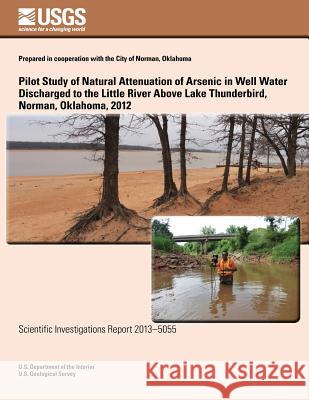Pilot Study of Natural Attenuation of Arsenic in Well Water Discharged to the Little River Above Lake Thunderbird, Norman, Oklahoma, 2012 » książka
Pilot Study of Natural Attenuation of Arsenic in Well Water Discharged to the Little River Above Lake Thunderbird, Norman, Oklahoma, 2012
ISBN-13: 9781500275136 / Angielski / Miękka / 2014 / 40 str.
Pilot Study of Natural Attenuation of Arsenic in Well Water Discharged to the Little River Above Lake Thunderbird, Norman, Oklahoma, 2012
ISBN-13: 9781500275136 / Angielski / Miękka / 2014 / 40 str.
(netto: 69,32 VAT: 5%)
Najniższa cena z 30 dni: 72,20 zł
ok. 16-18 dni roboczych
Bez gwarancji dostawy przed świętami
Darmowa dostawa!
The City of Norman, Oklahoma, wanted to augment its water supplies to meet the needs of an increasing population. Among the city's potential water sources are city wells that produce water that exceeds the 10 micrograms per liter primary drinking-water standard for arsenic. The City of Norman was interested in investigating low-cost means of using natural attenuation to remove arsenic from well water and augment the water supply of Lake Thunderbird, the primary water source for the city. The U.S. Geological Survey, in cooperation with the City of Norman, conducted a preliminary investigation (pilot study) to determine if discharge of water from those wells into the Little River over a 12-day period would reduce arsenic concentrations through natural-attenuation processes. Water in the Little River flows into Lake Thunderbird, the principal water source for the city, so the discharged well water would improve the water balance of that reservoir. During this pilot study, 150-250 gallons per minute from each of six city wells were discharged to the Little River over a 12-day period. Water-quality samples were collected from the wells during discharge and from the river before, during, and after well discharges. Streambed-sediment samples were collected at nine sites in the river before and after the well-discharge period. Water discharge from the six wells added 0.3 kilogram per day of arsenic to the river at the nearest downstream streamflow-gaging station. Dissolved arsenic concentration in the Little River at the closest downstream sampling site from the wells increased from about 4 micrograms per liter to as much as 24 micrograms per liter. Base flow in the river increased by about 1.7 cubic feet per second at the nearest downstream streamflow-gaging station. Streamflow in the river was two-thirds of that expected from the amount of water discharged from the wells because of seepage to soils and evapotranspiration of well water along drainage ways to the river. Arsenic concentrations at the nearest downstream streamflow-gaging station were less than arsenic concentrations measured in many of the well-water samples during the well-pumping period. Arsenic concentrations, loads, and yields in the Little River generally decreased downstream from the closest streamflow-gaging station to the wells by 50 percent or more, indicating removal of about 0.25 kilogram or 0.53 pound per day of arsenic during base-flow conditions. Measured river-water arsenic concentrations near the confluence of the Little River with Lake Thunderbird were in compliance with the primary drinking-water standard. Arsenic concentrations measured at four downstream stations in the Little River also were less than established criteria set for protection of aquatic biota. After well discharges to the Little River were stopped, arsenic concentrations, loads, and yields in the river gradually decreased over 14 days to concentrations measured prior to the well-water discharges. Cumulative loads of arsenic discharged at the wells and the closest and farthest downstream streamflow-gaging stations indicated removal of about 2.5 kilograms of arsenic as well-water flowed to and down the river. Arsenic concentrations in streambed-sediment samples collected before and after the well-water discharges were not significantly different. Results of this pilot study indicate that using natural-attenuation processes to remove arsenic from water and supplement city water supplies may be a viable, relatively low-cost method for attenuating arsenic in well water and for augmenting the water supply of Lake Thunderbird.
Zawartość książki może nie spełniać oczekiwań – reklamacje nie obejmują treści, która mogła nie być redakcyjnie ani merytorycznie opracowana.











